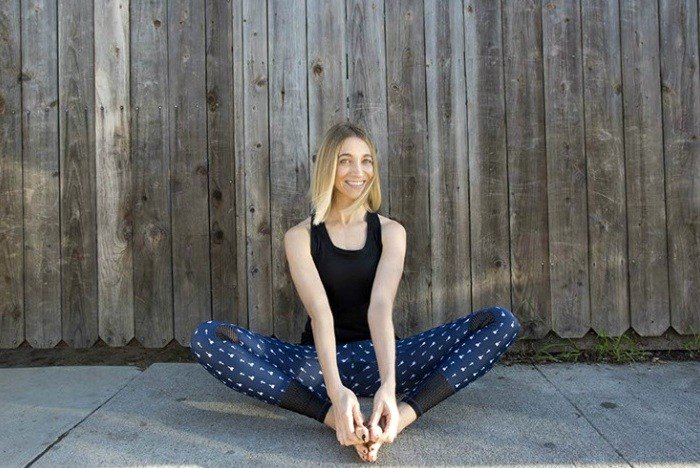Articles, In the Press, Uncategorized, Yoga Medicine® News
What I Learned About Life by Becoming a Yoga Teacher
by Erin Magner (200hr YTT student) for Well+Good.
Since the moment I started my media career over a decade ago, I’ve secretly fantasized about leaving it all behind and becoming a yoga teacher.
This is surprising to those who know me for several reasons. First of all, I adore my job as a journalist and people tell me I’m good at it. Like many writers, I’m a classic introvert; leading large group activities is not my jam. And even though I’ve been practicing yoga for over a decade, I’ve always kept that part of my life fairly private (you won’t find any selfies of me in mermaid pose).
And yet, from the day I first stepped onto a sticky mat, I’ve looked at yoga teachers with a mixture of envy and awe. They spend their days in serene, sun-dappled spaces instead of fluorescent-lit cubicles, listening to their favourite music and breathing in Palo Santo and lavender oil. They’re doing something that’s proven to reduce stress, rather than sitting through endless, mindless meetings. They radiate peace, warmth, and good vibes. They get to wear stretchy pants 24/7.
Finding my Path
So last summer, when I left my magazine job to study holistic nutrition—another longtime dream—I decided that I’d finally sign up for a 200-hour teacher training. It wasn’t because I saw myself actually becoming a yoga teacher (at the moment, I didn’t), but because it felt like a good time to deepen my practice and embrace being a full-time student again—this time, with headstands instead of keg stands.
I chose to study with Yoga Medicine founder Tiffany Cruikshank, the former acupuncturist and Nike HQ yoga teacher, because her vision—bringing together yoga and health care—dovetailed so neatly with my own. Plus, that particular 200-hour training partially took place in Tulum and Hawaii, which made me think that I’d also be getting two vacations out of the deal.
I was wrong—unless sitting on a concrete floor for eight hours a day, seven days straight, studying anatomy and alignment until your brain aches is your idea of R&R—but I got more value from those trips than I ever have from sipping margaritas while lounging on the sand.
Yes, I can now safely adjust someone in even the most lopsided triangle pose, but my biggest takeaways from teacher training have nothing to do with the physical practice of yoga. Everyone’s experience is different, but hopefully, the lessons I learned will help you jump off the fence if you’re currently on it—or maybe even give you a brand new goal to work towards in the future.
1. Don’t wait until you’re “perfect” at something.
I started researching teacher training about five years ago but thought I needed to put it off until I had mastered a wall-free handstand and could effortlessly do the splits. Eventually, I got over that—I still can’t do either of those things—and my decision was validated when I realized that all of my fellow students (and Tiffany herself, for that matter), have limitations of some sort. And no matter how long we practice, there will still be room for refinement. I’ve given up striving for perfection; instead, I celebrate little victories and am kind to myself on days when I can’t quite stick crow pose. It makes me look forward to my time on the mat that much more.
2. Knowledge is power—and a major confidence booster.
So you say you’re afraid of public speaking? Yeah, me too. But there’s a huge difference between giving a presentation and leading a yoga class. If you’re doing your job well, your students won’t be scrutinizing your every word—they’ll be focusing on their own breath and movement instead. Standing in front of a class can be scary, for sure, but for me, exhilaration and confidence overtake the fear once I see my students getting into that flow and letting go.
3. Go outside your comfort zone.
In the West, when people hear the word “yoga” they think about the physical practice. But yoga actually involves so much more than that—it’s an entire way of living mindfully. For me, immersing myself in the more spiritual side of the practice has been the most profound part of teacher training, since it’s something I hadn’t really experienced in my usual rotation of power yoga classes.
4. When you give joy, you get joy.
Without question, teaching yoga is hard work. I never realized how much went into preparing a class—developing the sequencing, curating a playlist, thinking about what the heck to say for an hour. But I’ve never felt anything as gratifying as having a student thank me and tell me that she feels better than she did when she walked into class. As a yoga teacher, you’re responsible for making an immediate, positive impact on someone’s day. Pretty cool.
5. No one expects you to have it all figured out.
As I mentioned before, I didn’t know whether I’d end up teaching yoga after finishing my training, and I still don’t—but I’m okay with that. If nothing else, I know I’m walking away with a rejuvenated devotion to this practice and a handful of new life lessons in my pocket. And that makes all these hours of studying bones, muscles, and mantras well worth it.













